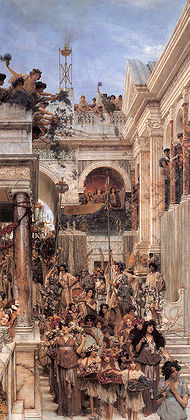
Cerealia
Encyclopedia

Religion in ancient Rome
Religion in ancient Rome encompassed the religious beliefs and cult practices regarded by the Romans as indigenous and central to their identity as a people, as well as the various and many cults imported from other peoples brought under Roman rule. Romans thus offered cult to innumerable deities...
, the Cerealia was the major festival celebrated for the grain goddess Ceres
Ceres (mythology)
In ancient Roman religion, Ceres was a goddess of agriculture, grain crops, fertility and motherly relationships. She was originally the central deity in Rome's so-called plebeian or Aventine Triad, then was paired with her daughter Proserpina in what Romans described as "the Greek rites of Ceres"...
. It was held for seven days from mid- to late April, but the dates are uncertain.
The festival may have been founded as early as the Regal period. Its archaic nature is indicated by a nighttime ritual described by Ovid
Ovid
Publius Ovidius Naso , known as Ovid in the English-speaking world, was a Roman poet who is best known as the author of the three major collections of erotic poetry: Heroides, Amores, and Ars Amatoria...
. Blazing torches were tied to the tails of live foxes, who were released into the Circus Maximus
Circus Maximus
The Circus Maximus is an ancient Roman chariot racing stadium and mass entertainment venue located in Rome, Italy. Situated in the valley between the Aventine and Palatine hills, it was the first and largest stadium in ancient Rome and its later Empire...
. The origin and purpose of this ritual are unknown; it may have been intended to cleanse the growing crops and protect them from disease and vermin, or to add warmth and vitality to their growth. Ovid offers an aetiological explanation: long ago, at ancient Carleoli, a farm-boy caught a fox stealing chickens and tried to burn it alive. The fox escaped, ablaze; in its flight it fired the fields and their crops, which were sacred to Ceres. Ever since, foxes are punished at her festival.
The Ludi
Ludi
Ludi were public games held for the benefit and entertainment of the Roman people . Ludi were held in conjunction with, or sometimes as the major feature of, Roman religious festivals, and were also presented as part of the cult of state.The earliest ludi were horse races in the circus...
Ceriales or "Games of Ceres" were held as part of the festival in the Circus Maximus. Ovid mentions that Ceres' search for her lost daughter Proserpina
Proserpina
Proserpina or Proserpine is an ancient Roman goddess whose story is the basis of a myth of Springtime. Her Greek goddess' equivalent is Persephone. The probable origin of her name comes from the Latin, "proserpere" or "to emerge," in respect to the growing of grain...
was represented by women clothed in white, running about with lighted torch
Torch
A torch is a fire source, usually a rod-shaped piece of wood with a rag soaked in pitch and/or some other flammable material wrapped around one end. Torches were often supported in sconces by brackets high up on walls, to throw light over corridors in stone structures such as castles or crypts...
es.
During the Republican era
Roman Republic
The Roman Republic was the period of the ancient Roman civilization where the government operated as a republic. It began with the overthrow of the Roman monarchy, traditionally dated around 508 BC, and its replacement by a government headed by two consuls, elected annually by the citizens and...
, the Cerealia was organised by the plebeian aedile
Aedile
Aedile was an office of the Roman Republic. Based in Rome, the aediles were responsible for maintenance of public buildings and regulation of public festivals. They also had powers to enforce public order. There were two pairs of aediles. Two aediles were from the ranks of plebeians and the other...
s, Ceres being one of the patron deities of the plebs
Plebs
The plebs was the general body of free land-owning Roman citizens in Ancient Rome. They were distinct from the higher order of the patricians. A member of the plebs was known as a plebeian...
or common people. The festival included ludi circenses, circus games. These opened with a horse race in the Circus Maximus, with a starting point just below the Aventine Temple of Ceres, Liber
Liber
In ancient Roman religion and mythology, Liber , also known as Liber Pater was a god of viticulture and wine, fertility and freedom. He was a patron deity of Rome's plebeians and was part of their Aventine Triad. His festival of Liberalia became associated with free speech and the rights...
and Libera
Libera
Libera may refer to:*Libera , a Roman goddess of fertility*Libera , a boy choir from London* Libera me, a movement of the Requiem*Libera, a song by Italian artist Mia Martini...
. After around 175 BC, the Cerealia included ludi scaenici, theatrical performances, held April 12–18. The plebeian aedile Gaius Memmius is credited with staging the first of these ludi scaenici. He also distributed a new commemorative denarius
Denarius
In the Roman currency system, the denarius was a small silver coin first minted in 211 BC. It was the most common coin produced for circulation but was slowly debased until its replacement by the antoninianus...
coin in honor of the event. His innovations led to his claiming to have presented "the first Cerealia."

